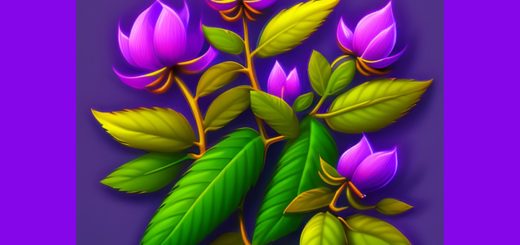Are Bananas Considered Herbs? A Fun Fact

Hey there, amazing readers! 🖐️ Just a quick note: yes, we know there are a lot of ads here. Trust us, we get it—it’s not the prettiest look, but they help us keep this blog alive and kicking. Those pesky little ads cover the costs of all the behind-the-scenes magic, from hosting and tech stuff to creating content we hope you’ll love.
We’re committed to delivering quality posts, and your support (even just sticking around despite the ads) means everything to us. So, bear with us, and thanks for helping us keep the good vibes rolling. Now, on to the fun stuff! 😉
TRANSLATE BUTTON AT THE END OF THE ARTICLE
A Quick Overview
Bananas are one of the most popular fruits in the world, enjoyed for their sweetness and convenience.
But did you know that bananas are technically classified as herbs?
It’s a fun fact that often surprises people.
This article delves into the botanical intricacies of bananas, highlighting their herbaceous nature, nutritional benefits, culinary uses, and cultural significance.
Join me as we peel back the layers of the banana plant’s fascinating characteristics.
Introduction: The Surprising World of Bananas
Bananas are more than just a delicious snack.
They have become a staple in many diets worldwide.
Who hasn’t grabbed a banana for a quick breakfast or thrown one into a smoothie?
But, here’s where it gets interesting: bananas don’t grow on trees.
Instead, they grow on large herbaceous plants, making them the largest herbs in the world!
That’s not something you hear every day.
This quirky classification stems from how we define trees versus herbs in the botanical sense.
Understanding this distinction invites a deeper appreciation for this humble fruit.
When you bite into a banana, you may picture a tropical tree swaying in the breeze.
But the truth is that what we call a banana tree is actually a giant herb with a unique growth structure.
So, let’s dive into what makes bananas so special, starting with a closer look at the definition of herbs.
What Defines a Herb? Understanding Botanical Terms
To understand why bananas are considered herbs, we first need to clarify what a herb is.
Botanically speaking, an herb is a plant that does not have a woody stem.
Instead, it has soft, green stems that die back at the end of the growing season.
Here are essential characteristics of herbs:
Soft Stems: Unlike trees with hard, woody stems, herbs have flexible stems.
Growth Habit: Herbs can grow to various heights, but they generally don’t reach the towering heights of trees.
Lifecycle: Many herbs are annual or perennial plants, completing their life cycles within one or two years, although some can live longer.
Bananas, however, challenge these definitions.
They are perennial, meaning they can live for several years, producing fruit seasonally.
This complexity is part of what makes bananas so intriguing.
They embody the characteristics of herbs while also displaying some behaviors typically associated with trees.
The Banana Plant: More Than Just a Fruit Bearer
You might picture a banana plant as a tropical oasis, but there’s much more to it.
The banana plant is classified under the genus Musa and is known for its impressive height, which can reach up to 30 feet.
But here’s the kicker: that height comes from its large leaves and a structure called a pseudostem.
What’s a pseudostem?
Not a True Stem: It’s formed by tightly packed leaf bases that give the plant its towering appearance.
Functionality: This structure supports the plant’s leaves and flowers, allowing it to reach for sunlight.
Banana plants can also produce multiple “hands” of bananas, each containing several individual bananas.
That’s right!
A bunch of bananas isn’t just one fruit; it’s a collection of many!
Unpacking the Banana’s Classification: Herbaceous Wonders
So, if bananas grow on herbaceous plants, why do we often think of them as trees?
It’s all about perception!
The banana plant’s sheer size can easily mislead anyone who sees it.
Interestingly, the classification of bananas as herbs doesn’t diminish their significance.
Here are some unique aspects of this classification:
Height: Some banana plants can rival trees in size, but they lack the rigid stems that define true trees.
Fruit Production: Like other herbs, banana plants focus on producing fruit rather than developing a woody trunk.
Root System: Banana plants have a fibrous root system that anchors them firmly in the ground but behaves differently than a tree’s root system.
When we recognize bananas as herbs, it opens up a new perspective on their role in agriculture and ecosystems.
Understanding this classification can lead us to better appreciate how these plants thrive.
The Anatomy of a Banana Plant: Leaves and Pseudostems
Banana plants boast some of the largest leaves in the plant kingdom, which can grow up to 10 feet long!
These impressive leaves are designed to capture sunlight efficiently.
The pseudostem, which resembles a tree trunk, supports these giant leaves, making the plant not just an impressive sight but also an efficient producer of energy through photosynthesis.
Each part of the banana plant plays a crucial role:
Leaves: They provide shade for the plant and help in photosynthesis.
Pseudostem: This is essential for structural support and is made up of tightly wrapped leaf sheaths.
Flowers and Fruits: These develop at the top of the plant and are arranged in clusters.
Each flower blossoms into a banana, creating the familiar fruit we love.
What’s fascinating is that bananas have a unique flowering process.
The flowering stalk emerges from the top of the pseudostem, producing large, vibrant flowers that eventually develop into bananas.
This process is mesmerizing and adds to the bananas’ allure.
Fun Fact: Bananas Are Technically Herbs, Not Fruits!
Here’s the fun part: despite being a beloved fruit, bananas are classified as herbs!
This surprising fact is often overlooked.
When we think of herbs, we usually think of plants like basil, parsley, or thyme.
Bananas, with their size and sweetness, don’t fit that mold at first glance.
So why do we call them fruits?
Culinary Use: In the kitchen, bananas are treated as fruits.
They’re sweet, easy to digest, and versatile, making them perfect for desserts or smoothies.
Botanical Classification: Botanically, a fruit is the mature ovary of a flowering plant, and bananas fit that description perfectly.
This duality makes bananas a fascinating subject in both botany and culinary arts.
They challenge our preconceived notions and encourage us to think outside the box.
Why Are Bananas Often Mistaken for Trees?
It’s easy to see why bananas are often mistaken for trees.
They can grow extraordinarily tall, and their broad leaves give off a tropical vibe that screams “tree.” However, the truth is that their structure and growth patterns are far from tree-like.
Some reasons for this mix-up include:
Height: Banana plants can soar up to 30 feet, making them resemble trees.
Leaf Size: The enormous leaves are reminiscent of palm trees, further adding to the confusion.
Cultural Imagery: Many tropical landscapes feature banana plants alongside palm trees, cementing their tree-like image in our minds.
This misunderstanding can lead to assumptions about how we cultivate and care for bananas.
It’s intriguing to think about how visual perceptions shape our understanding of nature.
The Growth Cycle of a Banana Plant: A Unique Journey
The life cycle of a banana plant is quite fascinating.
It starts with a small corm, which is a bulb-like underground stem.
From this corm, shoots emerge, growing into the tall banana plant we recognize.
Here’s a brief overview of the growth cycle:
Planting: A corm is planted in well-drained soil, ideally during the warm season.
Sprouting: Within a few weeks, shoots begin to emerge, growing rapidly.
Leaf Development: The plant grows large leaves that fan out, capturing sunlight.
Flowering: After several months, the flowering stalk emerges, leading to fruit production.
Harvesting: Bananas are harvested when still green and ripen off the plant, ready for our enjoyment.
This growth cycle is a testament to nature’s resilience and adaptability.
Each phase is critical, contributing to the overall success of the plant.
Nutritional Benefits: Why Bananas are a Super Herb!
Bananas are not just fun to say; they offer impressive nutritional benefits too!
Packed with vitamins, minerals, and fiber, they are a fantastic addition to any diet.
Key nutritional benefits include:
Potassium: Bananas are rich in potassium, which is essential for heart health and muscle function.
Vitamin C: This vitamin boosts your immune system and helps with the absorption of iron.
Dietary Fiber: Aids digestion and helps keep you feeling full.
Natural Sugars: They provide a quick energy boost, making them a great pre-workout snack.
Incorporating bananas into your diet can support overall health and well-being.
Plus, they’re convenient and tasty!
Culinary Uses of Bananas: From Snacks to Desserts
Bananas are incredibly versatile in the kitchen.
They can be eaten raw, cooked, and baked, making them a favorite ingredient for many dishes.
Some popular culinary uses include:
Smoothies: Blend bananas with yogurt and other fruits for a delicious drink.
Banana Bread: Overripe bananas make for moist and flavorful bread.
Pancakes: Add mashed bananas to pancake batter for a natural sweetness.
Toppings: Sliced bananas on oatmeal or cereal add a nutritious kick.
The possibilities are endless!
Whether you enjoy them in a dessert or as a snack, bananas boast a delightful sweetness that enhances many recipes.
Cultural Significance of Bananas Around the Globe
In many cultures, bananas hold symbolic meanings and are often featured in traditions and celebrations.
For example, in parts of Asia, bananas are considered symbols of fertility and prosperity.
In places like:
India: Bananas are used in religious ceremonies and are offered as prasadam (blessed food).
Hawaii: The banana plant is celebrated, and local festivals often highlight its importance in Hawaiian culture.
Africa: Bananas are a staple food source and play a significant role in local economies.
These cultural connections reinforce the idea that bananas are more than just a fruit; they carry deep-rooted meanings and histories that enrich our lives.
Conclusion: Embracing the Herbaceous Banana Delight!
So there you have it!
Bananas are not just some sweet, yellow fruit.
They are indeed herbs, capturing our hearts and taste buds while challenging our understanding of botanical classifications.
From their impressive growth cycle to their nutritional benefits and cultural significance, bananas weave a rich tapestry that celebrates the wonders of nature.
Next time you enjoy a banana, remember that you’re indulging in a remarkable herb that deserves appreciation.
Go ahead, share this fun fact with friends and family, and let them marvel at the herbaceous delight that is the banana!

The Enlightenment Journey is a remarkable collection of writings authored by a distinguished group of experts in the fields of spirituality, new age, and esoteric knowledge.
This anthology features a diverse assembly of well-experienced authors who bring their profound insights and credible perspectives to the forefront.
Each contributor possesses a wealth of knowledge and wisdom, making them authorities in their respective domains.
Together, they offer readers a transformative journey into the realms of spiritual growth, self-discovery, and esoteric enlightenment.
The Enlightenment Journey is a testament to the collective expertise of these luminaries, providing readers with a rich tapestry of ideas and information to illuminate their spiritual path.
Our Diverse Expertise 🌟
While our primary focus is on spirituality and esotericism, we are equally passionate about exploring a wide range of other topics and niches 🌍📚. Our experienced team is dedicated to delivering high-quality, informative content across various subjects ✨.
To ensure we provide the most accurate and valuable insights, we collaborate with trusted experts in their respective domains 🧑🏫👩🏫. This allows us to offer well-rounded perspectives and knowledge to our readers.
Our blog originally focused on spirituality and metaphysics, but we’ve since expanded to cover a wide range of niches. Don’t worry—we continue to publish a lot of articles on spirituality! Frequently visit our blog to explore our diverse content and stay tuned for more insightful reads.






